oil level FIAT FIORINO 2019 Owner handbook (in English)
[x] Cancel search | Manufacturer: FIAT, Model Year: 2019, Model line: FIORINO, Model: FIAT FIORINO 2019Pages: 220, PDF Size: 6.22 MB
Page 41 of 220
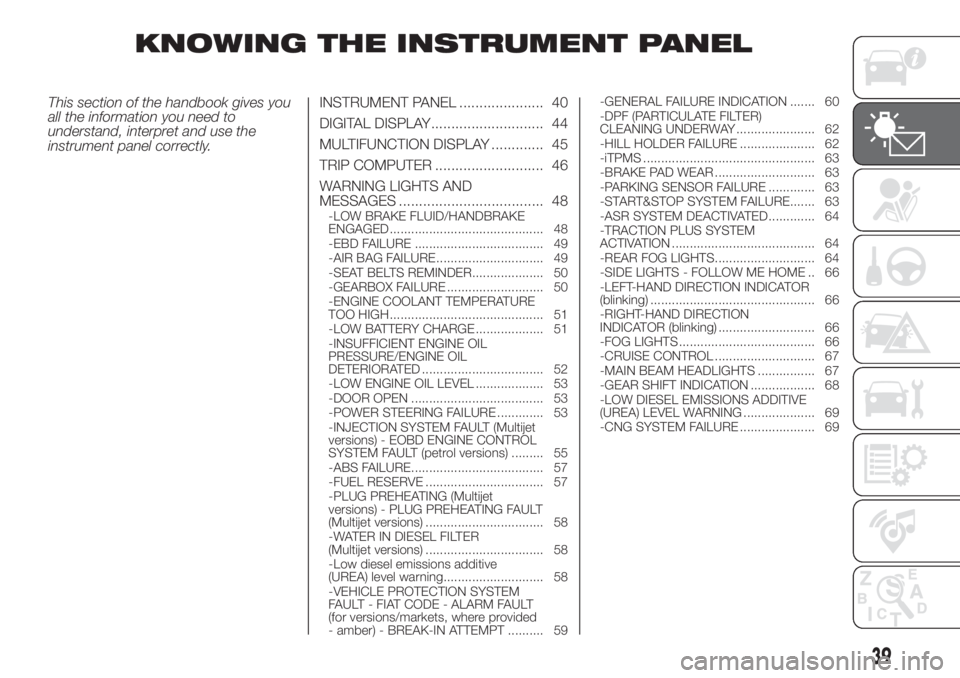
KNOWING THE INSTRUMENT PANEL
This section of the handbook gives you
all the information you need to
understand, interpret and use the
instrument panel correctly.INSTRUMENT PANEL ..................... 40
DIGITAL DISPLAY............................ 44
MULTIFUNCTION DISPLAY ............. 45
TRIP COMPUTER ........................... 46
WARNING LIGHTS AND
MESSAGES .................................... 48
-LOW BRAKE FLUID/HANDBRAKE
ENGAGED........................................... 48
-EBD FAILURE .................................... 49
-AIR BAG FAILURE .............................. 49
-SEAT BELTS REMINDER.................... 50
-GEARBOX FAILURE ........................... 50
-ENGINE COOLANT TEMPERATURE
TOO HIGH........................................... 51
-LOW BATTERY CHARGE ................... 51
-INSUFFICIENT ENGINE OIL
PRESSURE/ENGINE OIL
DETERIORATED .................................. 52
-LOW ENGINE OIL LEVEL ................... 53
-DOOR OPEN ..................................... 53
-POWER STEERING FAILURE ............. 53
-INJECTION SYSTEM FAULT (Multijet
versions) - EOBD ENGINE CONTROL
SYSTEM FAULT (petrol versions) ......... 55
-ABS FAILURE..................................... 57
-FUEL RESERVE ................................. 57
-PLUG PREHEATING (Multijet
versions) - PLUG PREHEATING FAULT
(Multijet versions) ................................. 58
-WATER IN DIESEL FILTER
(Multijet versions) ................................. 58
-Low diesel emissions additive
(UREA) level warning............................ 58
-VEHICLE PROTECTION SYSTEM
FAULT - FIAT CODE - ALARM FAULT
(for versions/markets, where provided
- amber) - BREAK-IN ATTEMPT .......... 59-GENERAL FAILURE INDICATION ....... 60
-DPF (PARTICULATE FILTER)
CLEANING UNDERWAY ...................... 62
-HILL HOLDER FAILURE ..................... 62
-iTPMS ................................................ 63
-BRAKE PAD WEAR ............................ 63
-PARKING SENSOR FAILURE ............. 63
-START&STOP SYSTEM FAILURE....... 63
-ASR SYSTEM DEACTIVATED ............. 64
-TRACTION PLUS SYSTEM
ACTIVATION ........................................ 64
-REAR FOG LIGHTS............................ 64
-SIDE LIGHTS - FOLLOW ME HOME .. 66
-LEFT-HAND DIRECTION INDICATOR
(blinking) .............................................. 66
-RIGHT-HAND DIRECTION
INDICATOR (blinking) ........................... 66
-FOG LIGHTS ...................................... 66
-CRUISE CONTROL ............................ 67
-MAIN BEAM HEADLIGHTS ................ 67
-GEAR SHIFT INDICATION .................. 68
-LOW DIESEL EMISSIONS ADDITIVE
(UREA) LEVEL WARNING .................... 69
-CNG SYSTEM FAILURE ..................... 69
39
Page 55 of 220

What it means What to do
redLOW ENGINE OIL LEVEL
When turning the ignition key to MAR, the warning
light turns on but it should go off after a few seconds.
This warning light appears on the panel when the
engine oil level falls below the minimum recommended
value.
On certain versions a dedicated message is displayed.Restore the correct engine oil level (see “Checking fluid
levels” in the "Servicing and care" section).
redDOOR OPEN
On certain versions, the warning light turns on when
one or more doors or the boot are not properly closed.
On some versions the display shows the dedicated
message.Check that all doors or the boot (for versions/markets,
where provided) are perfectly closed.
redPOWER STEERING FAILURE
When the ignition key is turned to MAR-ON the
warning light on the dial turns on, but it should turn off
after a few seconds.
If the warning light stays on together with the message
shown on the display and a buzzer, the power steering
is ineffective and the effort on the steering wheel
increases significantly even though the vehicle can be
steered.Contact a Fiat Dealership.
53
Page 146 of 220

SERVICE SCHEDULE
EURO 6 PETROL VERSIONS - NATURAL POWER VERSIONS
The checks listed in the Service Schedule, after reaching 180,000 km/12 years, must be cyclically repeated starting from the
first interval, thus following the same intervals as before.
Thousands of kilometres 30 60 90 120 150 180
Thousands of miles 18 36 54 72 90 108
Years 2 4 6 8 10 12
Check battery charge status and possibly recharge●●●●●●
Check tyre condition/wear and adjust pressure, if necessary; check
the condition/expiry date of the “Fix&Go Automatic” repair kit (for
versions/markets, where provided)●●●●●●
Check operation of lighting system (headlamps, direction indicators,
hazard warning lights, luggage compartment, passenger
compartment, glove compartment, instrument panel warning lights,
etc.)●●●●●●
Check and, if necessary, top up fluid levels (1)●●●●●●
Check exhaust emissions●●●●●●
Use the diagnosis socket to check supply/engine management
system operation, emissions and, for versions/markets, where
provided, engine oil degradation●●●●●●
Visually inspect condition of: exterior bodywork, underbody
protection, pipes and hoses (exhaust - fuel system - brakes), rubber
elements (boots, sleeves, bushes, etc.)●●●●●●
(1) Always only use the liquids shown in the handbook for topping up after having checked that the system is not damaged.
144
SERVICING AND CARE
Page 150 of 220
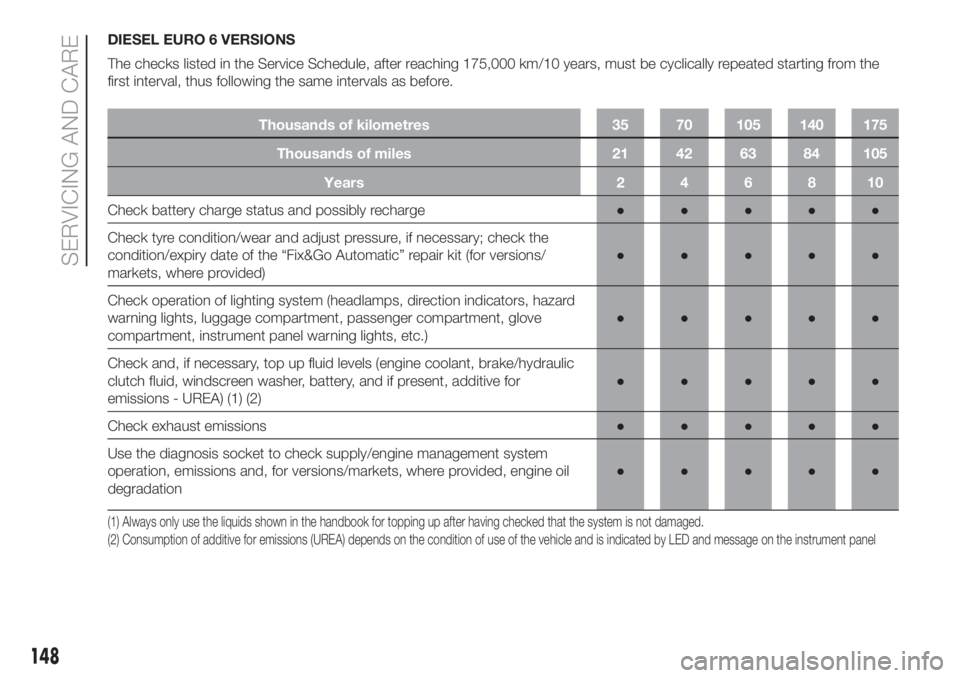
DIESEL EURO 6 VERSIONS
The checks listed in the Service Schedule, after reaching 175,000 km/10 years, must be cyclically repeated starting from the
first interval, thus following the same intervals as before.
Thousands of kilometres 35 70 105 140 175
Thousands of miles 21 42 63 84 105
Years 2 4 6 8 10
Check battery charge status and possibly recharge●●●●●
Check tyre condition/wear and adjust pressure, if necessary; check the
condition/expiry date of the “Fix&Go Automatic” repair kit (for versions/
markets, where provided)●●●●●
Check operation of lighting system (headlamps, direction indicators, hazard
warning lights, luggage compartment, passenger compartment, glove
compartment, instrument panel warning lights, etc.)●●●●●
Check and, if necessary, top up fluid levels (engine coolant, brake/hydraulic
clutch fluid, windscreen washer, battery, and if present, additive for
emissions - UREA) (1) (2)●●●●●
Check exhaust emissions●●●●●
Use the diagnosis socket to check supply/engine management system
operation, emissions and, for versions/markets, where provided, engine oil
degradation●●●●●
(1) Always only use the liquids shown in the handbook for topping up after having checked that the system is not damaged.
(2) Consumption of additive for emissions (UREA) depends on the condition of use of the vehicle and is indicated by LED and message on the instrument panel
148
SERVICING AND CARE
Page 151 of 220

Thousands of kilometres 35 70 105 140 175
Thousands of miles 21 42 63 84 105
Years 2 4 6 8 10
Visually inspect condition of: exterior bodywork, underbody protection,
pipes and hoses (exhaust - fuel system - brakes), rubber elements (boots,
sleeves, bushes, etc.)●●●●●
Check the position/wear of the windscreen/rear window wiper blades
(where provided)●●●●●
Check operation of windscreen washer/wiper, adjust jets●●●●●
Check cleanliness of bonnet locks, and cleanliness and lubrication of
linkages●●●●●
Check cleanliness of sliding side door lower guides (or every 6 months)●●●●●
Check handbrake lever travel and adjust, if necessary●●●●●
Check condition and wear of front disc brake pads and operation of pad
wear indicator●●●●●
Check rear drum brake lining condition and wear●●
Visually inspect condition of the accessory drive belt(s)●●
Check mechanical gearbox fluid●
Check transmission oil level (1.3 Multijet 80 HP Euro 6 versions with
COMFORT-MATIC transmission)●●●●●
149
Page 153 of 220
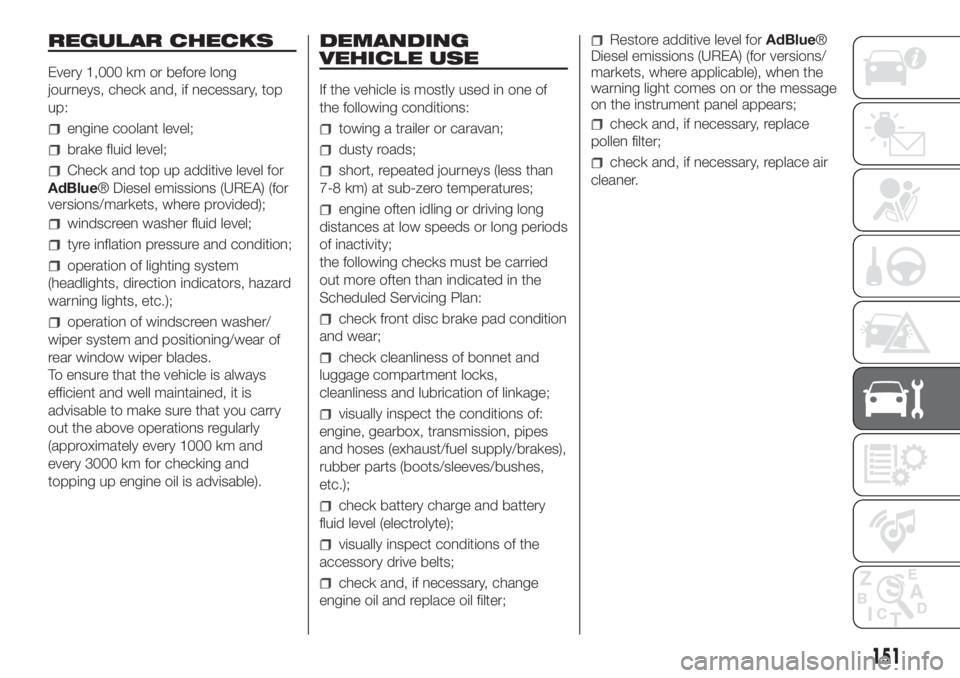
REGULAR CHECKS
Every 1,000 km or before long
journeys, check and, if necessary, top
up:
engine coolant level;
brake fluid level;
Check and top up additive level for
AdBlue® Diesel emissions (UREA) (for
versions/markets, where provided);
windscreen washer fluid level;
tyre inflation pressure and condition;
operation of lighting system
(headlights, direction indicators, hazard
warning lights, etc.);
operation of windscreen washer/
wiper system and positioning/wear of
rear window wiper blades.
To ensure that the vehicle is always
efficient and well maintained, it is
advisable to make sure that you carry
out the above operations regularly
(approximately every 1000 km and
every 3000 km for checking and
topping up engine oil is advisable).
DEMANDING
VEHICLE USE
If the vehicle is mostly used in one of
the following conditions:
towing a trailer or caravan;
dusty roads;
short, repeated journeys (less than
7-8 km) at sub-zero temperatures;
engine often idling or driving long
distances at low speeds or long periods
of inactivity;
the following checks must be carried
out more often than indicated in the
Scheduled Servicing Plan:
check front disc brake pad condition
and wear;
check cleanliness of bonnet and
luggage compartment locks,
cleanliness and lubrication of linkage;
visually inspect the conditions of:
engine, gearbox, transmission, pipes
and hoses (exhaust/fuel supply/brakes),
rubber parts (boots/sleeves/bushes,
etc.);
check battery charge and battery
fluid level (electrolyte);
visually inspect conditions of the
accessory drive belts;
check and, if necessary, change
engine oil and replace oil filter;
Restore additive level forAdBlue®
Diesel emissions (UREA) (for versions/
markets, where applicable), when the
warning light comes on or the message
on the instrument panel appears;
check and, if necessary, replace
pollen filter;
check and, if necessary, replace air
cleaner.
151
Page 154 of 220

CHECKING LEVELS
139)
36).
ENGINE COMPARTMENT.
1.4 Euro 6 versions
1. Engine oil dipstick 2. Engine oil cap/filler 3. Engine coolant 4. Windscreen/rear window washer fluid 5. Brake fluid 6. Power steering fluid
7. Battery
4
6
1
2
35
172F0T0512
152
SERVICING AND CARE
Page 158 of 220
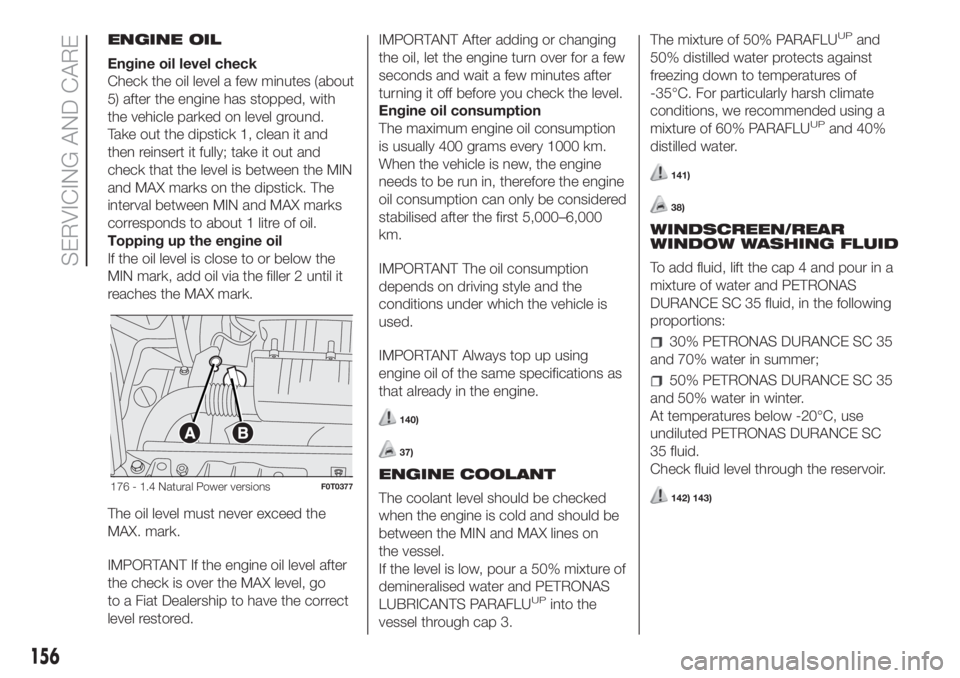
ENGINE OIL
Engine oil level check
Check the oil level a few minutes (about
5) after the engine has stopped, with
the vehicle parked on level ground.
Take out the dipstick 1, clean it and
then reinsert it fully; take it out and
check that the level is between the MIN
and MAX marks on the dipstick. The
interval between MIN and MAX marks
corresponds to about 1 litre of oil.
Topping up the engine oil
If the oil level is close to or below the
MIN mark, add oil via the filler 2 until it
reaches the MAX mark.
The oil level must never exceed the
MAX. mark.
IMPORTANT If the engine oil level after
the check is over the MAX level, go
to a Fiat Dealership to have the correct
level restored.IMPORTANT After adding or changing
the oil, let the engine turn over for a few
seconds and wait a few minutes after
turning it off before you check the level.
Engine oil consumption
The maximum engine oil consumption
is usually 400 grams every 1000 km.
When the vehicle is new, the engine
needs to be run in, therefore the engine
oil consumption can only be considered
stabilised after the first 5,000–6,000
km.
IMPORTANT The oil consumption
depends on driving style and the
conditions under which the vehicle is
used.
IMPORTANT Always top up using
engine oil of the same specifications as
that already in the engine.
140)
37)
ENGINE COOLANT
The coolant level should be checked
when the engine is cold and should be
between the MIN and MAX lines on
the vessel.
If the level is low, pour a 50% mixture of
demineralised water and PETRONAS
LUBRICANTS PARAFLU
UPinto the
vessel through cap 3.The mixture of 50% PARAFLU
UPand
50% distilled water protects against
freezing down to temperatures of
-35°C. For particularly harsh climate
conditions, we recommended using a
mixture of 60% PARAFLU
UPand 40%
distilled water.
141)
38)
WINDSCREEN/REAR
WINDOW WASHING FLUID
To add fluid, lift the cap 4 and pour in a
mixture of water and PETRONAS
DURANCE SC 35 fluid, in the following
proportions:
30% PETRONAS DURANCE SC 35
and 70% water in summer;
50% PETRONAS DURANCE SC 35
and 50% water in winter.
At temperatures below -20°C, use
undiluted PETRONAS DURANCE SC
35 fluid.
Check fluid level through the reservoir.
142) 143)176 - 1.4 Natural Power versionsF0T0377
156
SERVICING AND CARE
Page 159 of 220
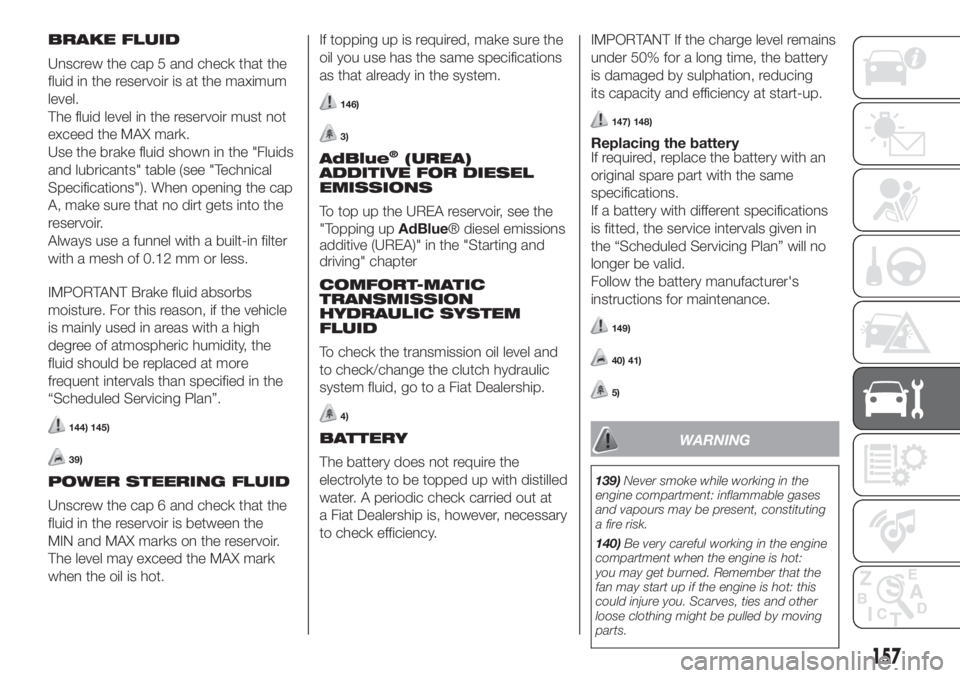
BRAKE FLUID
Unscrew the cap 5 and check that the
fluid in the reservoir is at the maximum
level.
The fluid level in the reservoir must not
exceed the MAX mark.
Use the brake fluid shown in the "Fluids
and lubricants" table (see "Technical
Specifications"). When opening the cap
A, make sure that no dirt gets into the
reservoir.
Always use a funnel with a built-in filter
with a mesh of 0.12 mm or less.
IMPORTANT Brake fluid absorbs
moisture. For this reason, if the vehicle
is mainly used in areas with a high
degree of atmospheric humidity, the
fluid should be replaced at more
frequent intervals than specified in the
“Scheduled Servicing Plan”.
144) 145)
39)
POWER STEERING FLUID
Unscrew the cap 6 and check that the
fluid in the reservoir is between the
MIN and MAX marks on the reservoir.
The level may exceed the MAX mark
when the oil is hot.If topping up is required, make sure the
oil you use has the same specifications
as that already in the system.
146)
3)
AdBlue®(UREA)
ADDITIVE FOR DIESEL
EMISSIONS
To top up the UREA reservoir, see the
"Topping upAdBlue® diesel emissions
additive (UREA)" in the "Starting and
driving" chapter
COMFORT-MATIC
TRANSMISSION
HYDRAULIC SYSTEM
FLUID
To check the transmission oil level and
to check/change the clutch hydraulic
system fluid, go to a Fiat Dealership.
4)
BATTERY
The battery does not require the
electrolyte to be topped up with distilled
water. A periodic check carried out at
a Fiat Dealership is, however, necessary
to check efficiency.IMPORTANT If the charge level remains
under 50% for a long time, the battery
is damaged by sulphation, reducing
its capacity and efficiency at start-up.
147) 148)
Replacing the battery
If required, replace the battery with an
original spare part with the same
specifications.
If a battery with different specifications
is fitted, the service intervals given in
the “Scheduled Servicing Plan” will no
longer be valid.
Follow the battery manufacturer's
instructions for maintenance.
149)
40) 41)
5)
WARNING
139)Never smoke while working in the
engine compartment: inflammable gases
and vapours may be present, constituting
a fire risk.
140)Be very careful working in the engine
compartment when the engine is hot:
you may get burned. Remember that the
fan may start up if the engine is hot: this
could injure you. Scarves, ties and other
loose clothing might be pulled by moving
parts.
157
Page 215 of 220
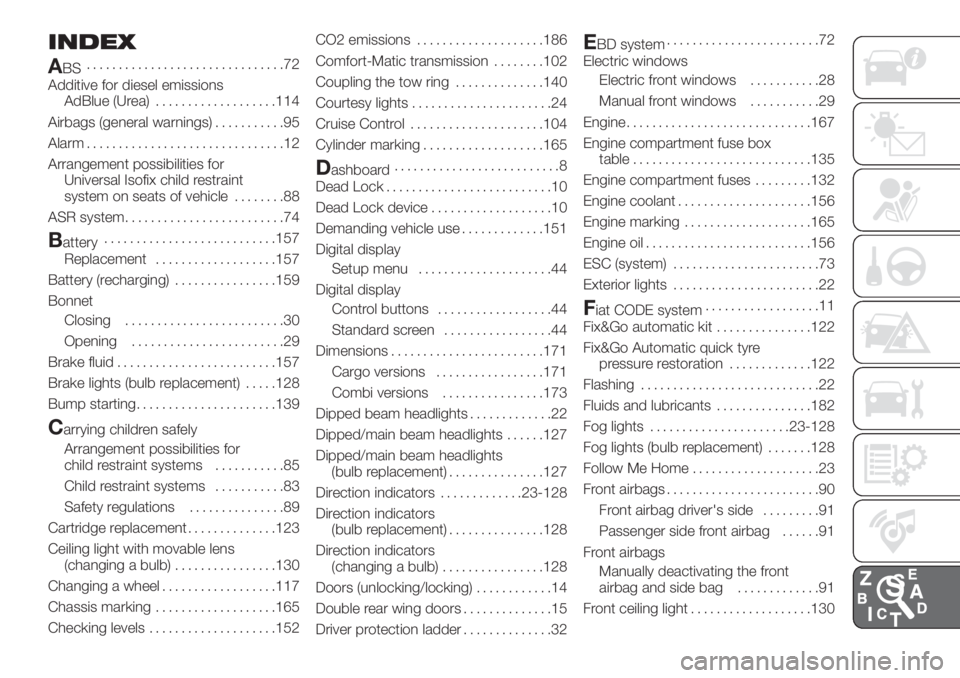
INDEX
A
BS...............................72
Additive for diesel emissions
AdBlue (Urea)...................114
Airbags (general warnings)...........95
Alarm...............................12
Arrangement possibilities for
Universal Isofix child restraint
system on seats of vehicle........88
ASR system.........................74
Battery...........................157
Replacement...................157
Battery (recharging)................159
Bonnet
Closing.........................30
Opening........................29
Brake fluid.........................157
Brake lights (bulb replacement).....128
Bump starting......................139
Carrying children safely
Arrangement possibilities for
child restraint systems...........85
Child restraint systems...........83
Safety regulations...............89
Cartridge replacement..............123
Ceiling light with movable lens
(changing a bulb)................130
Changing a wheel..................117
Chassis marking...................165
Checking levels....................152CO2 emissions....................186
Comfort-Matic transmission........102
Coupling the tow ring..............140
Courtesy lights......................24
Cruise Control.....................104
Cylinder marking...................165
Dashboard..........................8
Dead Lock..........................10
Dead Lock device...................10
Demanding vehicle use.............151
Digital display
Setup menu.....................44
Digital display
Control buttons..................44
Standard screen.................44
Dimensions........................171
Cargo versions.................171
Combi versions................173
Dipped beam headlights.............22
Dipped/main beam headlights......127
Dipped/main beam headlights
(bulb replacement)...............127
Direction indicators.............23-128
Direction indicators
(bulb replacement)...............128
Direction indicators
(changing a bulb)................128
Doors (unlocking/locking)............14
Double rear wing doors..............15
Driver protection ladder..............32
EBD system........................72
Electric windows
Electric front windows...........28
Manual front windows...........29
Engine.............................167
Engine compartment fuse box
table............................135
Engine compartment fuses.........132
Engine coolant.....................156
Engine marking....................165
Engine oil..........................156
ESC (system).......................73
Exterior lights.......................22
Fiat CODE system..................11
Fix&Go automatic kit...............122
Fix&Go Automatic quick tyre
pressure restoration.............122
Flashing............................22
Fluids and lubricants...............182
Fog lights......................23-128
Fog lights (bulb replacement).......128
Follow Me Home....................23
Front airbags........................90
Front airbag driver's side.........91
Passenger side front airbag......91
Front airbags
Manually deactivating the front
airbag and side bag.............91
Front ceiling light...................130